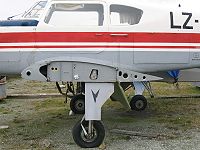- Clark Y
-
Clark Y is the name of a particular aerofoil profile, widely used in general purpose aircraft designs, and much studied in aerodynamics over the years. The profile was designed in 1922 by Virginius E. Clark. The airfoil has a thickness of 11.7 percent and is flat on the lower surface from 30 percent of chord back. The flat bottom simplifies angle measurements on propellers, and makes for easy construction of wings on a flat surface.
The Lockheed Vega is one example of the Clark Y used in practice. For many applications the Clark Y has been adequate; it gives reasonable overall performance in respect of its lift-to-drag ratio, and has gentle and relatively benign stall characteristics. But the flat lower surface is sub-optimal from an aerodynamic perspective, and it is rarely used in new designs. The Spirit of St. Louis used the Clark Y; the Piper Cub used the quite similar USA 35B.
The Clark YH airfoil was the same but with a reflexed (turned up) trailing edge producing a more positive pitching moment for improved longitudinal stability. The Hawker Hurricane used this profile. Мany Soviet aircraft of the 1930s and 1940s including all of the World War II Yakovlev fighters and MiG-3 used the Clark YH airfoil (Shavrov 1994).
Model aircraft
The Clark Y has found tremendous favour for the construction of model aircraft, thanks to the flight performance that the section offers at medium Reynolds number airflows. Application on model aircraft is very wide, ranging from free-flight gliders through to multi-engined radio control scale models.
The Clark Y is appealing thanks to its high camber, which produces a very good lift-to-drag ratio on comparatively lightweight balsa models, and for its near-horizontal lower surface, which aids in the accurate construction of wings on plans mounted on a flat construction board.
Young and inexperienced modellers are thus able to build model aircraft which provide a good flight performance due entirely to its aerofoil shape. The benign stalling characteristics of the airfoil are another aid, as this allows an inexperienced radio-control model hobbyist a better possibility of recovering from a stall in flight, to the benefit of the model.
The depth of the section lends itself to easier wing repair, as the modeller will often then have better access to balsa structural elements. In addition, the Clark Y section's depth also permits the flush installation of what are considered "standard" sized R/C servo motors within a wing for actuation of ailerons, flaps etc. , without an excessive reduction in performance.
References
- Шавров В.Б. (1994) История конструкций самолетов в СССР 1938-1950 гг. (3 изд.). Машиностроение (Shavrov V.B. (1994) Istoriia konstruktskii samoletov v SSSR, 1938-1950 gg. (3rd ed.). Mashinostroenie. ISBN 5-217-00477-0) (History of aircraft design in USSR: 1938-1950)
Categories:- Aerodynamics
- Aviation stubs
Wikimedia Foundation. 2010.


